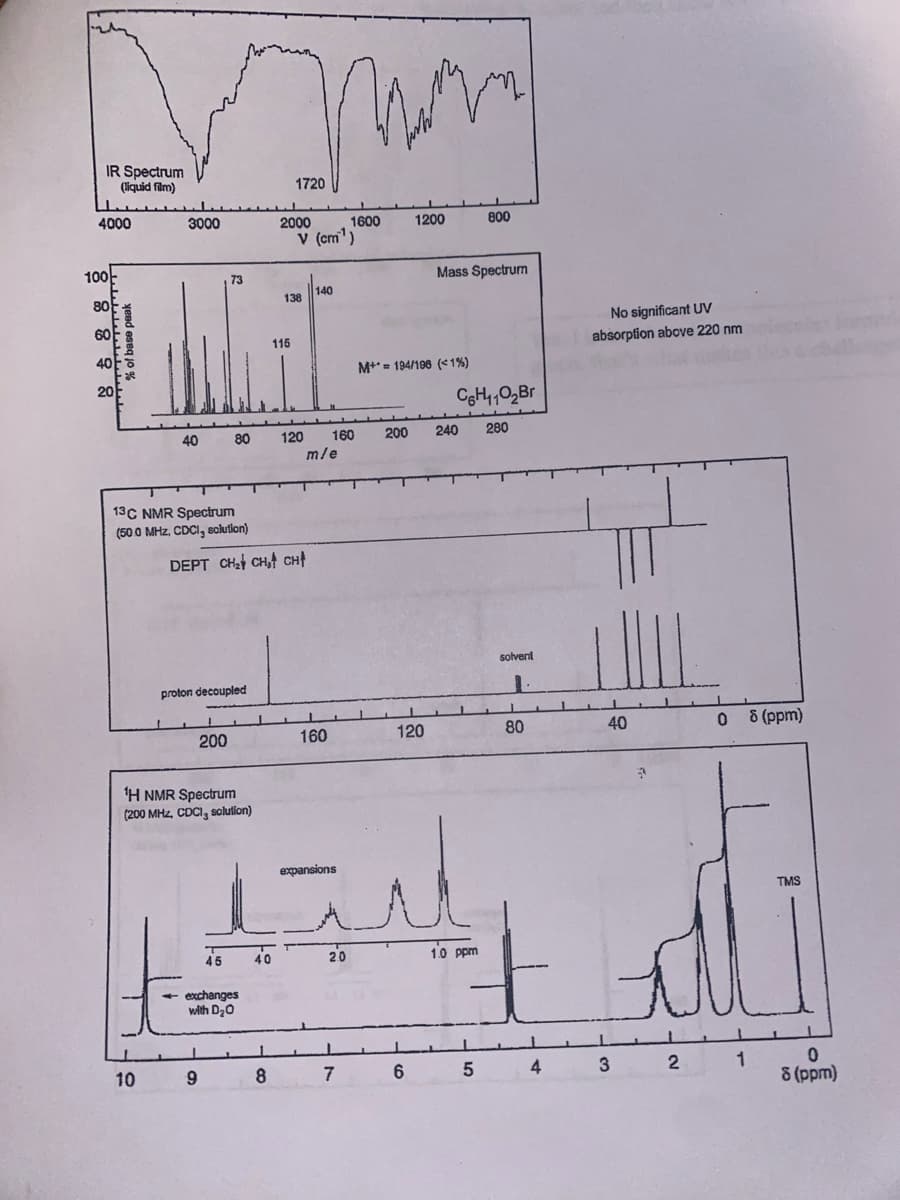IR Spectrum (liquid film) 4000 100 80 8 8 8 8 % of base peak 60 40 20 3000 40 10 13C NMR Spectrum (500 MHz, CDCI, solution) 73 200 80 proton decoupled ¹H NMR Spectrum (200 MHz, CDCI, solution) 45 9 exchanges with D₂0 DEPT CH₂ CH, CHI J M 1720 40 2000 8 138 116 V (cm¹) 140 120 160 m/e 1600 L 160 expansions ì 20 L 7 1200 M+ 194/198 (<1%) 120 Mass Spectrum 240 200 ill 6 C6H₁10₂Br 280 800 1.0 ppm 5 solvent 1 1 80 1 4 No significant UV absorption above 220 nm 40 L 3 1 2 08 (ppm) 1 TMS 0 8 (ppm)
IR Spectrum (liquid film) 4000 100 80 8 8 8 8 % of base peak 60 40 20 3000 40 10 13C NMR Spectrum (500 MHz, CDCI, solution) 73 200 80 proton decoupled ¹H NMR Spectrum (200 MHz, CDCI, solution) 45 9 exchanges with D₂0 DEPT CH₂ CH, CHI J M 1720 40 2000 8 138 116 V (cm¹) 140 120 160 m/e 1600 L 160 expansions ì 20 L 7 1200 M+ 194/198 (<1%) 120 Mass Spectrum 240 200 ill 6 C6H₁10₂Br 280 800 1.0 ppm 5 solvent 1 1 80 1 4 No significant UV absorption above 220 nm 40 L 3 1 2 08 (ppm) 1 TMS 0 8 (ppm)
Chapter12: Structure Determination: Mass Spectrometry And Infrared Spectroscopy
Section12.SE: Something Extra
Problem 48AP: The infrared spectrum of the compound with the mass spectrum shown below lacks any significant...
Related questions
Question
Provide the structure of the molecule that would give rise to these spectra. Include degree of unsaturation, functional groups present, assignment of 1H and 13C NMR peaks by labeling each peak with specific atoms in the structure (a,b,c,d) and show which atoms give rise at which peaks

Transcribed Image Text:IR Spectrum
(liquid film)
4000
100
80
60
40
20
% of base peak
3000
40
10
13C NMR Spectrum
(500 MHz, CDCI, solution)
73
200
80
proton decoupled
¹H NMR Spectrum
(200 MHz, CDCI, solution)
45
L
9
-exchanges
with D₂O
DEPT CH₂ CH₂ CH
1
40
1
8
1720
2000
115
138
V (cm1¹)
120
140
m/e
160
160
expansions
1600
20
A
7
m
1200
M+ 194/196 (<1%)
120
L
6
Mass Spectrum
240
200
C6H₁10₂Br
280
M
800
1.0 ppm
5
solvent
1.
1
80
4
No significant UV
absorption above 220 nm
40
1
3
2
08 (ppm)
1
TMS
0
8 (ppm)
Expert Solution
This question has been solved!
Explore an expertly crafted, step-by-step solution for a thorough understanding of key concepts.
This is a popular solution!
Trending now
This is a popular solution!
Step by step
Solved in 2 steps with 1 images

Knowledge Booster
Learn more about
Need a deep-dive on the concept behind this application? Look no further. Learn more about this topic, chemistry and related others by exploring similar questions and additional content below.Recommended textbooks for you


Macroscale and Microscale Organic Experiments
Chemistry
ISBN:
9781305577190
Author:
Kenneth L. Williamson, Katherine M. Masters
Publisher:
Brooks Cole

EBK A SMALL SCALE APPROACH TO ORGANIC L
Chemistry
ISBN:
9781305446021
Author:
Lampman
Publisher:
CENGAGE LEARNING - CONSIGNMENT


Macroscale and Microscale Organic Experiments
Chemistry
ISBN:
9781305577190
Author:
Kenneth L. Williamson, Katherine M. Masters
Publisher:
Brooks Cole

EBK A SMALL SCALE APPROACH TO ORGANIC L
Chemistry
ISBN:
9781305446021
Author:
Lampman
Publisher:
CENGAGE LEARNING - CONSIGNMENT